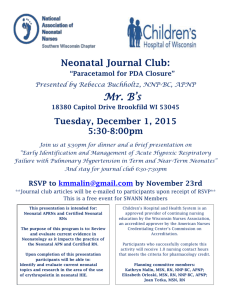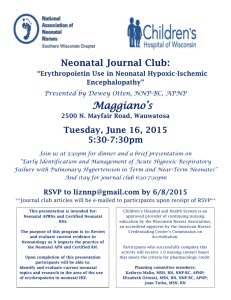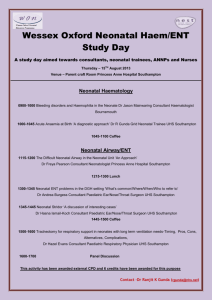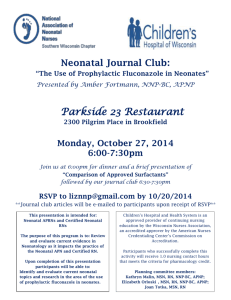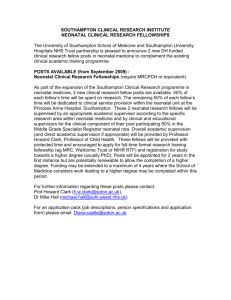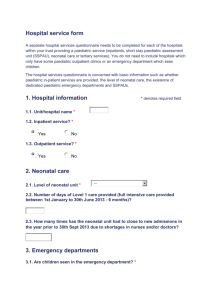Neonates RMO TD Nov 2013
advertisement
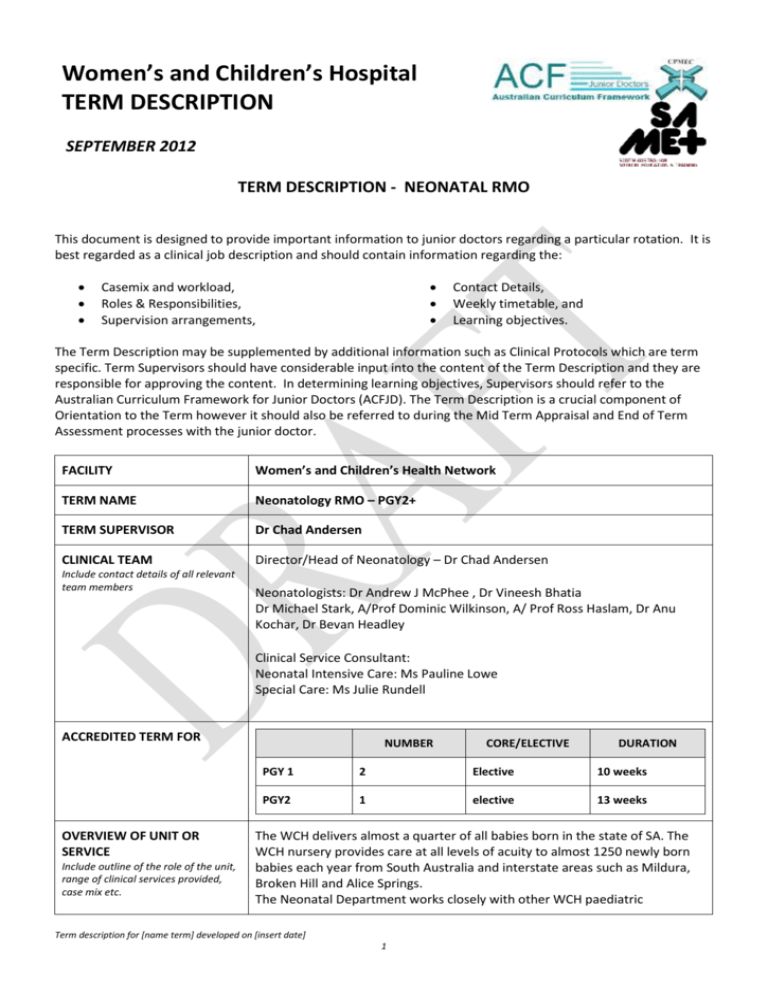
Women’s and Children’s Hospital TERM DESCRIPTION SEPTEMBER 2012 TERM DESCRIPTION - NEONATAL RMO This document is designed to provide important information to junior doctors regarding a particular rotation. It is best regarded as a clinical job description and should contain information regarding the: Casemix and workload, Roles & Responsibilities, Supervision arrangements, Contact Details, Weekly timetable, and Learning objectives. The Term Description may be supplemented by additional information such as Clinical Protocols which are term specific. Term Supervisors should have considerable input into the content of the Term Description and they are responsible for approving the content. In determining learning objectives, Supervisors should refer to the Australian Curriculum Framework for Junior Doctors (ACFJD). The Term Description is a crucial component of Orientation to the Term however it should also be referred to during the Mid Term Appraisal and End of Term Assessment processes with the junior doctor. FACILITY Women’s and Children’s Health Network TERM NAME Neonatology RMO – PGY2+ TERM SUPERVISOR Dr Chad Andersen CLINICAL TEAM Director/Head of Neonatology – Dr Chad Andersen Include contact details of all relevant team members Neonatologists: Dr Andrew J McPhee , Dr Vineesh Bhatia Dr Michael Stark, A/Prof Dominic Wilkinson, A/ Prof Ross Haslam, Dr Anu Kochar, Dr Bevan Headley Clinical Service Consultant: Neonatal Intensive Care: Ms Pauline Lowe Special Care: Ms Julie Rundell ACCREDITED TERM FOR OVERVIEW OF UNIT OR SERVICE Include outline of the role of the unit, range of clinical services provided, case mix etc. NUMBER CORE/ELECTIVE DURATION PGY 1 2 Elective 10 weeks PGY2 1 elective 13 weeks The WCH delivers almost a quarter of all babies born in the state of SA. The WCH nursery provides care at all levels of acuity to almost 1250 newly born babies each year from South Australia and interstate areas such as Mildura, Broken Hill and Alice Springs. The Neonatal Department works closely with other WCH paediatric Term description for [name term] developed on [insert date] 1 subspecialties and allied health departments. Care is provided by a team of neonatologists, registrars, neonatal nurse practitioners, neonatal intensive care nurses and nurses and midwives. The Neonatal Intensive Care Unit (NICU) at the WCH is unlike most others in Australia because of the broad spectrum of newborns it receives and cares for. It is the largest NICU service in SA providing high acuity medical and surgical services. The Special Care Nursery includes newly born babies and graduates of NICU who require a range of services incorporating high dependency, observation and transitional care / low dependency care. The post natal ward provides care to healthy, mostly term or near term newborns delivered at WCH. The Following Clinical Services are provided by the WCH Neonatal Department; Neonatal Intensive Care Special Care / High dependency Postnatal / Transitional Care Neonatal Outpatient Clinic Growth and Development Clinic Antenatal Diagnosis and Counselling MedSTAR Kids (Neonatal Emergency Transport) REQUIREMENTS FOR COMMENCING THE TERM: Identify the knowledge or skills required by the TMO before commencing the Term and how the term supervisor will determine competency ORIENTATION Include detail regarding the arrangements for Orientation to the Term, including who is responsible for providing the Term Orientation and any additional resource documents such as clinical policies and guidelines required as reference material for the junior doctor. Basic knowledge of newborn examination, cardiopulmonary transition and other adaptations to extra-uterine life, common neonatal conditions, and newborn feeding. Good interpersonal skills, communication and ability to work in a busy multidisciplinary environment. The RMO will receive orientation on the first day of the rotation. This will be conducted by the Term Supervisor or Director. The orientation will provide the RMO with a brief overview of the day to day running of the unit, administrative requirements, educational opportunities, and expectations. Following the introduction the RMO will receive a tour of the facilities The RMO will receive a training session on Newborn Resuscitation in the first week of the rotation. An orientation guide, specific to Neonatology, will also be provided to all RMOs. The guide is a detailed document that provides an outline of the neonatal service including MO shifts, duties, timing of ward rounds, contacts pertaining to their area of duty, teaching and educational activities. This document also has some key articles and clinical scenarios. The RMOs should ensure that they take the time to view this document and provide the requested information. The Term Supervisor will provide this to the RMO. Term description for [name term] developed on [insert date] 2 It is essential for the RMO to attend orientation before starting their Term JUNIOR DOCTOR’S CLINICAL RESPONSIBILITIES AND TASKS List routine duties and responsibilities including clinical handover It is envisaged that the RMO will spend time in three clinical settings throughout their Neonatology rotation. Each clinical setting is closely supervised by an assigned Paediatric Registrar / Clinical Fellow / Neonatal Nurse Practitioner and a Neonatal Consultant. These are; Clinical setting A: Special Care Clinical setting B: Post natal ward Clinical setting C: Attendance at Deliveries Night duty Clinical setting A: Special Care: Includes responsibility with a Special Care Registrar / Neonatal Nurser Practitioner for newborns in Special Care Baby Unit I (SCBU I), SCBU II and SCBU III nurseries. Ward Round: Assessment of babies with Registrar and Consultant including discussion of management, treatment planning, ordering of investigations, referrals, examination of babies and discharge planning. Follow up and communication of investigation results, discharge examinations, procedures and discharge summaries. Patient Assessments – All initial patient assessments should be carried out under the direct supervision of a registrar or consultant. Subsequent follow up and discussions in relation to the same patient should be held with the same senior medical officer (SMO) Presenting cases - when presenting cases the RMO should include an attempted formulated differential diagnoses, outlining appropriate investigations and a treatment plan Investigations - investigation must be initiated in an expeditious manner once determined by a SMO. Referrals - instruction from a SMO to make a referral to an inpatient team must be acted upon expeditiously. Procedures - discuss all procedures with a SMO before commencing. Close supervision and assistance is indicated for complex or unfamiliar procedures. It is the RMO’s responsibility to clean up after the procedure. Documentation – documentation is regarded as highly important. Every patient assessment should be documented in the case note and must include date, time, signature and stamped details (name and provider number) Computerised records – these records are just as important and should be accurate and complete Communication – Communication with nursing staff, senior medical staff and families should be carried out in a timely and effective manner. Discharging from Nursery – All patient discharges must be planned with a Consultant or Registrar. Every patient should have a discharge summary letter provided on discharge which should be checked by a consultant before distribution. Term description for [name term] developed on [insert date] 3 Clinical setting B: Post Natal Includes responsibility with a Post Natal Registrar / Nurse Practitioner for babies on the post natal ward. Ward Round 0900 onwards: Assessment of babies with post natal Registrar / Neonatal Nurse Practitioner including newborn checks, management of common neonatal conditions and discharge examinations including organisation and communication of appropriate follow-up. Ward Round 1100 – 1200 Follow up working round with allocated consultant. Patient Assessments – All initial patient assessments should be carried out under direct supervision of registrar or consultant. Subsequent follow up and discussions in relation to the same patient should be held with the same senior medical officer (SMO). Presenting cases - when presenting cases the RMO should include an attempted formulated differential diagnoses, outlining appropriate investigations and a treatment plan Investigations - investigation must be initiated in an expeditious manner once determined by a SMO. Referrals - instruction from a SMO to make a referral to an inpatient team must be acted upon immediately Procedures - discuss all procedures with a SMO before commencing. Close supervision and assistance is indicated for complex or unfamiliar procedures. It is the RMOs responsibility to clean up after the procedure. Documentation – documentation is regarded as highly important. Every patient assessment should be documented in the case note and must include date, time, signature and stamped details (name and provider number) Computerised records – these records are just as important and should be accurate and complete Communication – Communication with nursing staff, senior medical staff and families should be carried out in a timely manner. Discharging from Nursery – All patient discharges must be planned with a Registrar / Neonatal Nurse Practitioner and Consultant. Every patient should have a discharge summary letter provided on discharge which should be checked by a consultant before distribution. Clinical setting C: Attendance at Deliveries Delivery room attendance where a Neonatal staff member is required, including planned and emergency caesarean sections and deliveries with expectant compromised newly born babies. Night Duty Includes responsibility for Special Care, Post natal ward, babies attending Women’s Assessment Service and Delivery suite with direct supervision of a Paediatric registrar / Neonatal Nurse Practitioner. Please note: the opportunity for the RMO to be rostered for Clinical setting C will be dependent upon the RMO’s capacity to manage demanding neonatal clinical problems and situations. It is expected that the RMO’s capacity to do Term description for [name term] developed on [insert date] 4 this will be demonstrated during the first half of their term. The Term Supervisor will have regular discussions with the RMO outlining the skills they need to develop to be confident in working in Clinical setting C. During their formative mid-term assessment the RMO will receive written feedback and a possible offer of participating in Clinical setting C. SUPERVISION Identify staff members with responsibility for Junior Doctor Supervision and the mechanisms for contacting them, including after hours. Contact details provided should be specific for that Term. IN HOURS The RMO will be supervised by the Consultant, Fellow, Registrar and Neonatal Nurse Practitioners all of whom are in-house and carry pagers. All staff contacts are available on the roster and in the orientation manual. AFTER HOURS The RMO will have rostered time as the Delivery Attendant after hours. This will be supervised by the Consultant, Fellow, Registrar and Neonatal Nurse Practitioners all of whom are in-house and carry pagers. UNIT SPECIFIC TERM OBJECTIVES* CLINICAL MANAGEMENT The Term Supervisor should identify the knowledge, skills and experience that the junior doctor should expect to acquire that are specific to the Term. This should include reference to the attached ACFJD. Term Specific: 1. Newborn resuscitation 2. Newborn examination 3. Newborn admission and discharge 4. Management of common neonatal problems *Generic term objectives should also be noted on the attached ACFJD document. Both Unit specific and generic term objectives should be used as a basis of the mid and end of Term assessments. The RMO should concentrate on perfecting the following ACF competencies. History & Examination Recognises how patients present with common acute problems and conditions Elicits symptoms and signs relevant to the presenting problem or condition Undertakes and can justify clinically relevant patient assessments Problem formulation Synthesises clinical information to generate a ranked problem list containing appropriate provisional diagnoses Regularly re-evaluates the patient problem list as part of the clinical reasoning process Referral and Consultation Identifies and provides relevant and succinct information Applies the criteria for referral or consultation relevant to a particular problem or condition Collaborate with other health professionals in patient assessment Management options Identifies and can justify the patient management options for common problems and condition Implements and evaluates a management plan relevant to patient following discussion with a senior clinician Therapeutics Involves nurses, pharmacists and allied health professionals appropriately in medication management Investigations Selects, requests and can justify investigations in the context of Term description for [name term] developed on [insert date] 5 particular patient presentation Identifies and provides relevant and succinct information when ordering investigations Discharge Planning Identifies the elements of effective discharge planning e.g. early, continuous, multidisciplinary Follows organisational guidelines to ensure smooth discharge Decision Making Selects appropriate procedures with involvement of senior clinicians and the patient Informed Consent Applies the principles of informed consent in day to day clinical practice Identifies the circumstances that require informed consent to be obtained by a more senior clinician Procedures Uses appropriate analgesia and/or premedication COMMUNICATION Written communication Demonstrates high quality written skills i.e. legible writing, concise and informative discharge summaries Uses appropriate structure and content for specific correspondence i.e. referrals, investigation request, GP letters Uses the health care record to ensure continuity of care Electronic records Uses electronic resources in patient care i.e. obtaining results, discharge summaries, pharmacopoeia Handover Describes the importance and features of handover that ensure patient safety and continuity of care Performs effective handover with team members and multidisciplinary teams PROFESSIONALISM Professional Standards Complies with the legal requirements of being a doctor Adheres to professional standards Respects patient privacy and confidentiality Time management Prioritises workload to maximise patient outcomes and health service function Demonstrates punctuality EDUCATION Detail learning and education opportunities and resources available to the junior doctor during the Term. Formal education opportunities should also be included in the unit timetable below. EDUCATION TIMETABLE Day Time Education Venue Frequency Monday 0800- X-ray / X-ray Room Weekly Term description for [name term] developed on [insert date] 6 0900 Antenatal Round Level 3, Queen Victoria Building 12301330 Medical Round Maxwell Seminar Room Uni Dept of Paediatrics Level 2, Rieger Building Weekly 0830 Respiratory Round NICU Level 3, Queen Victoria Building Weekly Wednesday 12301330 Grand Round QVB Lecture Theatre Level 1, Queen Victoria Building Weekly Thursday Neonatal Journal Club Nursery Seminar Room Level 3, Queen Victoria Building Weekly Tuesday 07300830 Weekly Friday 08300930 Neonatal Grand Round 12301330 Antenatal Diagnosis & Counselling Meeting 14001500 Neonatal teaching NICU Level 3, Queen Victoria Building Weekly QVB Lecture Theatre Level 1, Queen Victoria Building X-ray Room Level 3, Queen Victoria Building Weekly TIMETABLE The timetable should include term specific education opportunities, Facility wide education opportunities e.g TMO education sessions, ward rounds, theatre sessions (where relevant), inpatient time, outpatient clinics etc. It is not intended to be a roster but rather a guide to the activities that the TMO should participate in during the week. Term description for [name term] developed on [insert date] 7 Weekly Schedule Clinical Setting A: Special Care Monday (0800-1630) 0800-0900 Radiology Round Tuesday 0900-1630 Wednesday 0900-1630 Thursday 0730-1630 0730-0830 Neonatal Journal Club 0830 – 0930 Neonatal Grand Round 1230-1300 Grand Round 1230-1330 ADACS meeting Friday 0900-1630 0900-1200 SCBU Round with Paed Reg / NNP and Consultant 1230-1330 Medical round 1400-1600 Patient reviews in Special care including Observation nursery, follow up, d/c summaries 1400-1500 Neonatal Teaching 1600-1630 Handover with Paed Reg / NNP and Consultant Weekly Schedule Clinical setting B: Post natal Monday 0800-1630 Tuesday 0800-1630 Wednesday 0800-1630 0800-0900 Radiology Round Thursday 0730-1630 0730-0830 Neonatal Journal Club 0830 – 0930 Neonatal Grand Round 0900-1100 Patient reviews, assessment with Paed reg / NNP 1100-1200 Consultant round 1230-1330 Medical round 1230-1300 Grand Round 1400-1600 Term description for [name term] developed on [insert date] 8 1230-1330 ADACS meeting Friday 0800-1630 Patient reviews, follow up of Invest, d/c summaries with Paed Reg/ NNP 1400-1500 Neonatal Teaching Weekly Schedule Clinical setting C: Delivery attendant Day duty: Monday (0730-1300) 0800-0900 Radiology Round Tuesday 0730 - 1300 Wednesday 0730 - 1300 Thursday 0730 - 1300 0730-0830 Neonatal Journal Club 0830 – 0930 Neonatal Grand Round Friday 0730 - 1300 0900-1300 Delivery attendance 1400-1500 Neonatal Teaching Night duty Monday 1900 - 0745 Tuesday 1900 - 0745 Wednesday 1900 - 0745 Thursday 1900 - 0745 Friday 1900 - 0745 Delivery attendance Special care PATIENT LOAD: Average number of patients looked after by the junior doctor per day OVERTIME Average hours per week On average the RMO will see approximately 20-40 newborns each days as a mixture of newly admitted and currently admitted newborns. Rostered Overtime Minimal. Term description for [name term] developed on [insert date] 9 Un-Rostered Overtime Relatively rare ASSESSMENT AND FEEDBACK Detail the arrangements for formal assessment and feedback provided to junior doctor during and at the end of the Term. Specifically, a mid-term assessment must be scheduled to provide the junior doctor with the opportunity to address any shortcomings prior to the end-of-term assessment. ADDITIONAL INFORMATION End-Term Assessment It is the Junior Doctor’s responsibility to make an appointment with their supervisor to discuss their term assessment. The assessment will cover clinical skills, team dynamics and communication with the relatives and families. The term supervisor will then complete an end of term online assessment form for WCH and the MEO will send this completed document to the Junior Doctor for their record. Mid-Term Assessment The RMO will have a mid-term discussion with their supervisor. If there are any performance concerns these will be raised and also discussed with the DCT. Before commencing please view the Neonatal Orientation manual. Timesheets Timesheets are available form the Office Of Department Of Perinatal Medicine. Please submit them by Thursday noon of relevant pay fortnight Sick leave Any Sick leave to be informed to On Duty Consultant Dress code Neat casual clothing with closed shoes is the minimum standard expected. Surgical scrubs may be worn, but must be supplied by the wearer (WCH does not supply scrubs for staff other than in the operating theatres). For requirements relating to supervision, feedback, assessment and performance improvement, please refer to the Intern Handbook. For information on the ACF please go to: http://www.cpmec.org.au/Page/acfjd-project TERM DESCRIPTION DEVELOPED ON October 2013 TERM DESCRIPTION VALID UNTIL October 2014 DUE FOR REVIEW ON WCH aims to review all Term Descriptions annually. *********ATTACH RELEVANT CHECKLIST FOR ACFJDs TO THIS TERM DESCRIPTION******* Term description for [name term] developed on [insert date] 10 Regularly re-evaluates the patient problem list as part of the clinical reasoning process National Term Description Adheres to professional standards Respects patient privacy & confidentiality Investigations Selects, requests and can justify investigations in the context of particular patient presentation Follows up and interprets investigation results appropriately to guide patient management Identifies and provides relevant and succinct information when ordering investigations Referral & Consultation Identifies & provides relevant & succinct information Applies the criteria for referral or consultation relevant to a particular problem or condition Collaborate with other health professionals in patient assessment Subacute Care Identifies appropriate subacute care services for a patient Identifies patients suitable for aged care, rehabilitation or palliative care programs Ambulatory & Community Care Identifies and arranges ambulatory and community care services appropriate for each CLINICAL MANAGEMENT patient Safe Patient Care Discharge Planning Systems Identifies the elements of effective discharge Works in ways which acknowledge the planning e.g. early, continuous, complex interaction between the multidisciplinary healthcare environment, doctor & patient Follows organisational guidelines to ensure Uses mechanisms that minimise error e.g. smooth discharge Emergencies checklists, clinical pathways Identifies and refers patients to residential Participates in continuous quality improvement Assessment care consistent with clinical indications Recognises the abnormal physiology & clinical e.g. clinical audit and regulatory requirements (ADV) manifestations of critical illness Risk & Prevention End of Life Care Recognises & effectively assesses acutely ill, Identifies the main sources of error & risk in Arranges appropriate support for dying deteriorating or dying patients the workplace patients Initiates resuscitation when clinically indicated Recognises and acts on personal factors whilst continuing full assessment of the patient Skills & Procedures which may contribute to patient and staff risk Explains and reports potential risks to patients Prioritisation Decision-making Describes the principles of triage & staff Explains the indications and contraindications Identifies patients requiring immediate for common procedures Adverse Events & Near Misses resuscitation & when to call for help e.g. Code Describes examples of the harm caused by Selects appropriate procedures with Blue / MET errors & system failures involvement of senior clinicians and the Provides clinical care in order of medical Documents & reports adverse events in patient priority accordance with local incident reporting Informed Consent Basic Life Support systems Applies the principles of informed consent in Implements basic airway management, Recognises & manages adverse events & day to day clinical practice ventilatory & circulatory support near misses (ADV) Identifies the circumstances that require Effectively uses semi-automatic and automatic informed consent to be obtained by a more Public Health defibrillators senior clinician Informs authorities of each case of a 'notifiable Advanced Life Support disease' Provides a full explanation of procedures to Identifies the indications for advanced airway Acts in accordance with the management plan patients management for a disease outbreak Preparation & Anaesthesia Recognises malignant arrhythmias, uses Identifies the determinants of the key health Prepares & positions the patient appropriately resuscitation/drug protocols & manual issues and opportunities for disease Recognises the indications for local, regional defibrillation prevention in the community (ADV) or general anaesthesia (ADV) Participates in decision-making about & Arranges appropriate equipment & describes Infection Control debriefing after cessation of resuscitation its use Practices correct hand-washing and aseptic Acute Patient Transfer techniques Procedures Identifies factors that need to be addressed for Uses methods to minimise transmission of Provides appropriate analgesia and/or patient transfer infection between patients premedication Identifies and manages risks prior to and Rationally prescribes antibiotic/antiviral Arranges appropriate support staff & defines during patient transfer (ADV) therapy for common conditions their roles Radiation Safety Patient Management Post-procedure Minimise the risk to patient or self associated Monitors the patient & provides appropriate with exposure to radiological investigations or Management Options aftercare Identifies and can justify the patient procedures Identifies & manages common complications management options for common problems Rationally requests radiological investigations Interprets results & evaluates outcomes of and conditions and procedures treatment Implements and evaluates a management Regularly evaluates his/her ordering of plan relevant to the patient following radiological investigations and procedures PROFESSIONALISM discussion with a senior clinician (ADV) Therapeutics Doctor & Society Medication Safety When prescribing, takes account of the Identifies the medications most commonly Access to Healthcare actions and interactions, indications, involved in prescribing & administration errors Identifies how physical or cognitive disability monitoring requirements, contraindications & Prescribes & administers medications safely can limit patients’ access to healthcare potential adverse effects of each medication Routinely reports medication errors & near services used misses in accordance with local requirements Provides access to culturally appropriate Involves nurses, pharmacists & allied health healthcare professionals appropriately in medication Patient Assessment Demonstrates a non-discriminatory approach management Patient Identification to patient care Evaluates the outcomes of medication therapy Follows the stages of a verification process to Culture, Society & Healthcare (ADV) ensure the correct identification of a patient Behaves in ways which acknowledge the Pain Management Complies with the organisation's procedures social, economic & political factors in patient Specifies and can justify the hierarchy of for avoiding patient misidentification illness therapies and options for pain control Confirms with others the correct identification Behaves in ways which acknowledge the Prescribes pain therapies to match the of a patient impact of culture, ethnicity & spirituality on patient’s analgesia requirements (ADV) History & Examination health Evaluates the pain management plan to Recognises how patients present with Identifies his/her own cultural values that may ensure it is clinically relevant (ADV) common acute and chronic problems and impact on his/her role as a doctor Fluid, Electrolyte & Blood Product Management conditions Identifies the indications for and risks of fluid & Indigenous Patients Elicits symptoms & signs relevant to the Behaves in ways which acknowledge the electrolyte therapy and use of blood products presenting problem or condition impact of history & the experience of Recognises and manages the clinical Undertakes and can justify clinically relevant Indigenous Australians consequences of fluid & electrolyte imbalance patient assessments Behaves in ways which acknowledge in a patient Problem Formulation Indigenous Australians' spirituality & Develops, implements, evaluates and Synthesises clinical information to generate a relationship to the land maintains an individualised patient ranked problem list containing appropriate Behaves in ways which acknowledge the management plan for fluid, electrolyte and provisional diagnoses diversity of indigenous cultures, experiences & blood product use Discriminates between the possible differential communities Maintains a clinically relevant patient diagnoses relevant to a patient's Professional Standards management plan of fluid, electrolyte and presenting problems or conditions Complies with the legal requirements of being blood product use with relevant pathology a doctor e.g. maintaining registration testing (ADV) Neonatology Intern, WCH Term description for [name term] developed on [insert date] 11 Medicine & the Law Complies with the legal requirements in patient care e.g. Mental Health Act, death certification Completes appropriate medico-legal documentation Liaises with legal & statutory authorities, including mandatory reporting where applicable (ADV) Health Promotions Advocates for healthy lifestyles and explains environmental & lifestyle risks to health Uses a non-judgemental approach to patients & his/her lifestyle choices (e.g. discusses options; offers choice) Evaluates the positive and negative aspects of health screening and prevention when making healthcare decisions (ADV) Healthcare Resources Identifies the potential impact of resource constraint on patient care Uses finite healthcare resources wisely to achieve the best outcomes Behaves in ways that acknowledge the complexities and competing demands of the healthcare system (ADV) Professional Behaviour Professional Responsibility Behaves in ways which acknowledge the professional responsibilities relevant to his/her health care role Maintains an appropriate standard of professional practice & works within personal capabilities Reflects on personal experiences, actions & decision-making Acts as a role model of professional behaviour Time Management Prioritises workload to maximise patient outcomes and health service function Demonstrates punctuality Personal Well-being Is aware of and optimises personal health & well-being Behaves in ways to mitigate the personal health risks of medical practice e.g. fatigue, stress Behaves in ways which mitigate the potential risk to others from your own health status e.g. infection Ethical Practice Behaves in ways which acknowledge the ethical complexity of practice & follow professional & ethical codes Consults colleagues about ethical concerns Accepts responsibility for ethical decisions Practitioner in Difficulty Identifies the support services available Recognises the signs of a colleague in difficulty Refers appropriately & responds with empathy Doctors as Leaders Shows an ability to work well with and lead others Exhibits the qualities of a good leader and takes the leadership role when required (ADV) Professional Development Explores and is open to a variety of career options Participates in a variety of continuing education opportunities Teaching, Learning & Supervision Self-directed Learning Identifies and addresses personal learning objectives Establishes and uses current evidence based resources to support own learning Seeks opportunities to reflect on and learn from clinical practice Seeks and responds to feedback on learning Participates in research and quality improvement activities where possible Teaching Plans, develops and conducts teaching sessions for peers and juniors Uses varied approaches to teaching small and large groups Incorporates teaching into clinical work Evaluates and responds to feedback on own teaching Supervision Provides effective supervision e.g. by being available, offering an orientation, learning opportunities, and by being a role model Adapts level of supervision to the learner’s competence and confidence Assessment & Feedback Provides constructive, timely and specific feedback based on observation of performance Participates in feedback and assessment processes Provides constructive guidance or refers to an appropriate support to address problems (ADV) Uses electronic patient information & decision- Gastrointestinal support systems recognizing his/her strengths Abdominal pain and limitations Constipation Uses electronic resources in patient care e.g. Diarrhoea to obtain results, discharge summaries, Gastrointestinal bleeding pharmacopoeia Jaundice Complies with policies regarding information Liver disease technology e.g. passwords, e-mail &internet Nausea and Vomiting General Cognitive or physical disability Functional decline or impairment Genetically determined conditions Haemopoietic Anaemia Health Records Complies with legal/institutional requirements for health records Uses the health record to ensure continuity of care Facilitates appropriate coding & classification by accurate documentation Evidence-based Practice Describes the principles of evidence-based practice & hierarchy of evidence Uses best available evidence in clinical decision-making (ADV) Critically appraises evidence & information (ADV) Handover Describe the importance and features of handover that ensure patient safety and continuity of care Performs effective handover e.g. team member to team member, hospital to GP to ensure patient safety and continuity of care Immunology Anaphylaxis Infectious Diseases Non-specific febrile illness Septicaemia Sexually Transmitted Infections Mental State Disturbed or aggressive patient Musculoskeletal Joint disorders COMMUNICATION Neurological Patient Interaction Delirium Falls, especially in the elderly Context Headache Arranges an appropriate environment for Loss of consciousness communication, e.g. private, no interruptions Seizure disorders Uses principles of good communication to Spinal disease ensure effective healthcare relationships Stroke / TIA Uses effective strategies to deal with the Subarachnoid haemorrhage difficult or vulnerable patient Working in Teams Syncope Respect Team Structure Nutrition / Metabolic Treats patients courteously & respectfully, Identifies the healthcare team (e.g. medical Weight gain showing awareness & sensitivity to different team, multidisciplinary stroke team) most Weight loss backgrounds appropriate for a patient Maintains privacy & confidentiality Obstetric Includes the patient & carers in the team Provides clear & honest information to Pain and bleeding in pregnancy decision making process where possible patients & respects their treatment choices Oncology Identifies that team leaders can be from Providing Information Neoplasia different health professions and respects their Applies the principles of good communication roles Oral Disease (e.g. verbal and non verbal) and Uses graded assertiveness when appropriate Oral Infections communicates with patients and carers in Respects the roles & responsibilities of team Toothache ways they understand members Pharmacology / Toxicology Uses interpreters for non English speaking Team Dynamics Envenomation backgrounds when appropriate Contributes to teamwork by behaving in ways Poisoning Involves patients in discussions and decisions that maximises the teams’ effectiveness Psychiatric / Drug & Alcohol about their care including teams which extend outside the Addiction (smoking, alcohol, drug) Meetings with Families or Carers hospital Anxiety Identifies the impact of family dynamics on Demonstrates an ability to work with others Deliberate self-harm effective communication and resolve conflicts when they arise Dementia Ensures relevant family/carers are included Demonstrates flexibility & ability to adapt to Depression appropriately in meetings and decision-making change Psychosis Respects the role of families in patient health Teams in Action Substance abuse care Identifies and adopts a variety of roles within a Renal / Urogynaecological Breaking Bad News team (ADV) Abnormal menstruation Identifies symptoms and signs of loss and Case Presentation Contraception bereavement Presents cases effectively, to senior medical Dysuria &/or frequent micturition Participates in breaking bad news to patients staff & other health professionals Pyelonephritis and UTIs & carers Reduced urinary output Shows empathy & compassion Renal failure CLINICAL PROBLEMS & Open Disclosure Urinary Incontinence Explains and participates in implementing the CONDITIONS Respiratory principles of open disclosure Circulatory Asthma Ensures patients and carers are supported & Cardiac arrhythmias Breathlessness cared for after an adverse event Chest pain Chronic Obstructive Pulmonary Disease Complaints Electrolyte disturbances Cough Acts to minimise or prevent the factors that Hypertension Obstructive sleep apnoea would otherwise lead to complaints Heart failure Pleural diseases Uses local protocols to respond to complaints Ischaemic heart disease Pneumonia / respiratory infection Adopts behaviours such as good Leg ulcers Upper airway obstruction communication designed to prevent Limb ischaemia complaints Thromboembolytic disease SKILLS & PROCEDURES Critical Care / Emergency Managing Information General Child abuse Diagnostic Written Domestic violence Blood culture Complies with organisational policies Elder abuse Blood Sugar Testing regarding timely and accurate documentation Injury prevention Wound swab Demonstrates high quality written skills e.g. Minor trauma writes legible, concise & informative discharge Injections Multiple trauma summaries Intramuscular injections Non-accidental injury Uses appropriate structure & content for Joint aspiration or injection (ADV) Postoperative care specific correspondence e.g. referrals, Subcutaneous injections Shock investigation requests, GP letters Interpretation of results Dermatological Accurately documents drug prescription and Nuclear Medicine Skin conditions administration Pathology Skin malignancies Electronic Radiology Endocrine Intravenous Diabetes: new cases & complications Term description for [name term] developed on [insert date] 12 Intravenous cannulation Intravenous drug administration Intravenous fluid & electrolyte therapy Intravenous infusion set up Venepuncture Measurement Blood pressure Pulse oximetry Respiratory Bag & Mask ventilation LMA and ETT placement (ADV) Nebuliser/inhaler therapy Oxygen therapy Therapeutics/Prophylaxis Analgesia Antibiotic Anticoagulant Bronchodilators Insulin Steroids Cardiopulmonary 12 lead electrocardiogram recording and interpretation Arterial blood gas sampling and interpretation Central venous line insertion (ADV) Peak flow measurement Pleural effusion/pneumothorax aspiration Spirometry Child Health Apgar score estimation (ADV) Infant respiratory distress assessment Infant/child dehydration assessment Neonatal and Paediatric Resuscitation (ADV) Newborn examination Ear, Nose & Throat Anterior rhinoscopy Anterior nasal pack insertion Auroscopy/otoscopy External auditory canal irrigation External auditory canal ear wick insertion (ADV) Throat swab Gastrointestinal Abdominal paracentesis (ADV) Anoscopy/proctoscopy (ADV) Nasogastric tube insertion Rectal examination Mental Health Alcohol withdrawal scale use Application of Mental Health Schedule Mini-mental state examination Psychiatric Mental State Examination Suicide risk assessment Neurological Assessment of Neck stiffness Focal neurological sign identification Glasgow Coma Scale (GCS) scoring Lumbar puncture (ADV) Papilloedema identification (ADV) Ophthalmic Eye drop administration Eye bandage application Eye irrigation Eyelid eversion Corneal foreign body removal Direct ophthalmoscopy Intraocular pressure estimation (ADV) Slit lamp examination (ADV) Visual acuity assessment Visual field assessment Surgical Assisting in the operating theatre Complex wound suturing (ADV) Local anaesthesia Scrub, gown & glove Simple skin lesion excision Surgical knots & simple wound suturing Suture removal Trauma Cervical collar application In-line immobilisation of cervical spine Intercostal catheter insertion (ADV) Joint relocation Peripheral neurovascular assessment Plaster cast/splint limb immobilisation Pressure haemostasis Primary trauma survey Secondary trauma survey (ADV) Volume resuscitation Urogenital Bladder catheterisation (M&F) Bladder Scan Urethral swab Urine dipstick interpretation Women’s Health Diagnosis of Pregnancy Endocervical swab / PAP smear Foetal heart sound detection Gynaecological pelvic examination Palpation of the pregnant abdomen Speculum examination Urine pregnancy testing Term description for [name term] developed on [insert date] 13

